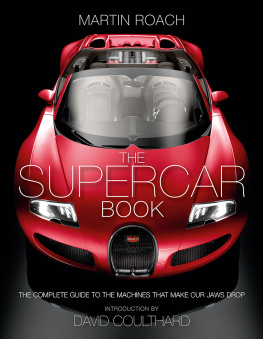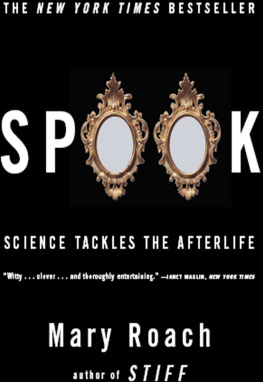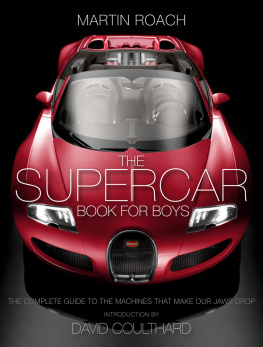A huge number of people have been incredibly helpful to me in the making of this book, and I am indebted to all of them. I would specifically like to mention the following:
Extra special thanks to DC for his Introduction and to Dr Schreiber for his Afterword.
Many thanks to the following people for their interviews and valuable time: Nick Mason, Dr Walliser, Alex Karidis, John Morrison, Dominik Amian, The Prodigy, Keith Flint, Keeti Palmer and Joe Macari. Many thanks to Liam Howlett for his interview and constant expertise, particularly on all things Porsche.
Peter Read you have been a huge help, and I am enormously grateful, with special thanks. Also thanks to the Royal Automobile Club, Tom Purves, Ben Cussons, Michael Quinn, David Bagley, Peter Foubister, Guy Nicholls and Jemma Rapson.
The following manufacturers were hugely helpful: Bentley, Lamborghini, McLaren, Mercedes-Benz, Daimler AG and Porsche. Also Steve the mans a legend Higgins, Damien Percheron, Juliet Jarvis and all at JJC, as well as Gerhard Heidbrink, Rob Durrant, Ed Redfern, Silvie Kiefer and Mercedes-Benz Classic.
Special thanks to the McLaren family for their help with photos of the M6GT. Also thanks to Ian Hunt for his amazing photographs, David Kimber and www.carphoto.co.uk, and Geoff Fennell for his painstaking design work.
Big thanks to Hedge, Adam and Luke Matthews for their research and ideas, my wife Kaye Roach, Lambo Joe Yapp, Mario Nichols, Paul Stephens, Mark Buzz Wells, Leigh Naylor, Oliver Smith-Davis and Rob Davis, Simon Holland, Sophie Yamamoto, Dave Clarke and DPC Media, as well as Ferrari S.p.A.
Thanks also to Steve Griggs, Anita Krizsan, Adrian Crowe, Jack Barclays in Mayfair, Lotus, Simon Gerratt, Natalie Jerome, Laura Lees, Manuela Hoehne, Julius Kruta, Emanuela Wilm, Marie-Louise Fritz, Adrian Davies, Wolfgang Glabus, Joanne Hassall, Jeremy Mitchell, Supercar Connect, Victoria Gilbert, Ten Tenths, Chris Craft, Mike Orford, Natalie Chandler, David Delgado, John Manning, Porsche Mayfair, Avril Smith, David Joyce, Porsche Sutton Coldfield, Nick Hine, Porsche Club Great Britain, Chris Seaward, Justine Bowen, Tim Doyle, Doc Brown, Keith Holland, Dr Kerry Spackman, James Bond, Neil Waterman, Martyn Goddard, Paul Burrows, SuperVettura, Alex Wilson, Mr Bun the Baker and Luke Gilbertson.
Finally, extra special thanks to both Caitlin Doyle at Harper Collins and Rory Scarfe for their belief in this project and enormous energy and passion for this book. Both worked many long, hard hours on this book under extreme pressure, and I am sincerely grateful for all that they have done.
Afterword by Dr Wolfgang Schreiber,
President of Bugatti and CEO and Chairman of Bentley
A supercar has to be an emotional experience. There are some very obvious criteria that qualify a car as a supercar, but for me the emotion it excites is perhaps the single-most important factor. Yes, a supercar needs high performance or a technical element that sets it apart from anything else; it is usually made in only a limited production run; a high price is to be expected; the statistics and performance numbers matter; the look has to be striking, too; people look to a certain pedigree of supercar also. All of those things count, but above all, it has to be emotional.
This emotion is not just for the owner to experience. Only a lucky few people buy supercars, but around the world there are millions of fans. For example, there are only about 400 Bugatti Veyrons in the world, and most of them are parked up or garaged, so you cant even see them. Yet Bugatti has more than two million fans on social media. Very young people enjoy supercars, too. They know very well what a supercar is, they know what it takes and they want to know more all the time. Supercars become a part of their life. This is what supercars do.
Great supercars also have a personality of their own: a character. You want to own a car that has a soul. Some supercars take you racing, some are easy to drive, some can do both, but all good supercars have these distinct personalities. Whenever I drive a Bugatti Veyron, it gives me a feeling of changing the fundamentals of physics, because you cant believe what that car can do. I was lucky enough to have the opportunity to work on the Veyron. This means that a part of me is embedded in that car, but its soul and personality still surprise me to this day.
This personality is strongest in the best supercars. You can park a genuine supercar wherever you want in the street without any danger of someone scratching it. People dont damage a real supercar; they just stand back and admire it. They might stroke it, but they dont scratch it.
There is a serious side to this automotive indulgence, of course. Supercar manufacturers are responsible for keeping an eye on the planet, so the need to develop electric cars, find alternative energy sources, plug-in hybrids, all of that has to be a part of the future of supercars. Also, the technology we create with supercars does filter down, which is very important for the wider car industry. That is a given.
However, there is no logical reason behind creating a supercar. Nonetheless, it is human to want to push boundaries, to create, to evolve. That impulse will never go away. We have to keep pushing forward.
When I was a kid, I had posters of some old Bentleys on my bedroom wall, a few V8 muscle cars, the Jaguar E-Type and also a Porsche 911. I used to look at them, and they gave me an emotional, exciting feeling. And when I see a supercar now, as an adult, I get exactly the same feeling. In that sense, nothing has changed for me. You need to still feel like the boy looking at those posters. If I cannot become a boy again when I sit in a supercar, then I cannot do my job properly. At times, yes, you need to be a senior manager or a chief engineer, and there are some very serious elements of my work, but in all of our jobs we need to have moments when we are that boy again, looking at those posters, getting that emotional attachment, that excitement, otherwise you lose something very important. It has to come from the heart and the petrol head.
Nobody puts supercars in the scrapyard. You hand these cars down to your kids. These cars stay always in your mind. Even if you dont own a supercar, they live in the minds of people, in books like this one that Martin has written, in culture, in conversation, in life.
Supercars dont die. They live forever.
Dr Wolfgang Schreiber, President of Bugatti and CEO and Chairman of Bentley
The Lamborghini Countach is considered by many to be the definitive supercar and was the childhood dream car of millions of kids around the world.
When I was a kid, I had a poster of a red Lamborghini Countach on my wall. I had seen a Countach on a school trip to London and my mind was completely blown away by this spaceship on wheels, this creation, this other-worldly machine that seemed to have landed from another planet. That weekend I went to a shop called Athena with my pocket money and bought that Countach poster, as well as a small, white, die-cast model of the same car.
I have been fascinated by supercars ever since, much to the annoyance of my wife and to the detriment of my bank account, which is repeatedly depleted by purchases of essential die-cast models to add to my collection. Throughout my childhood and into my adulthood that die-cast collection grew, and so did my fascination with supercars, and this has ultimately led me to write this book.
Next page















